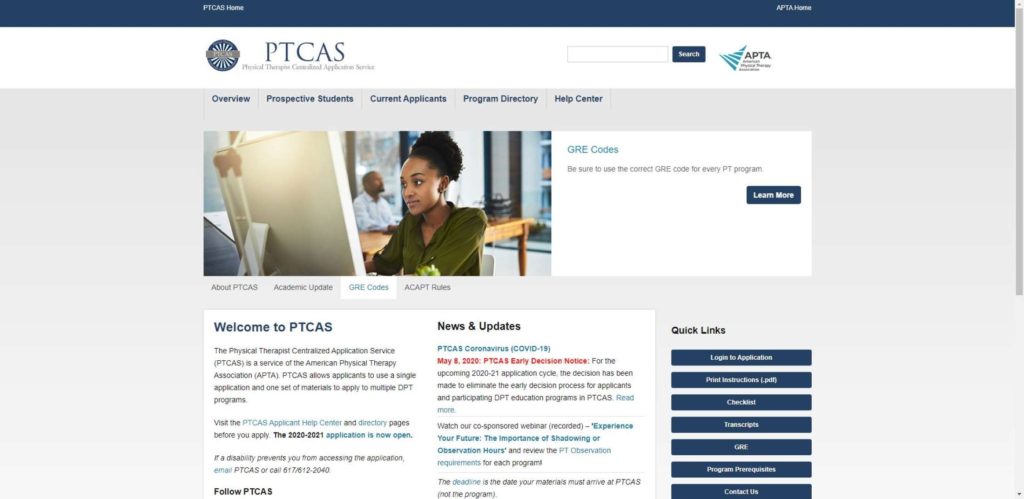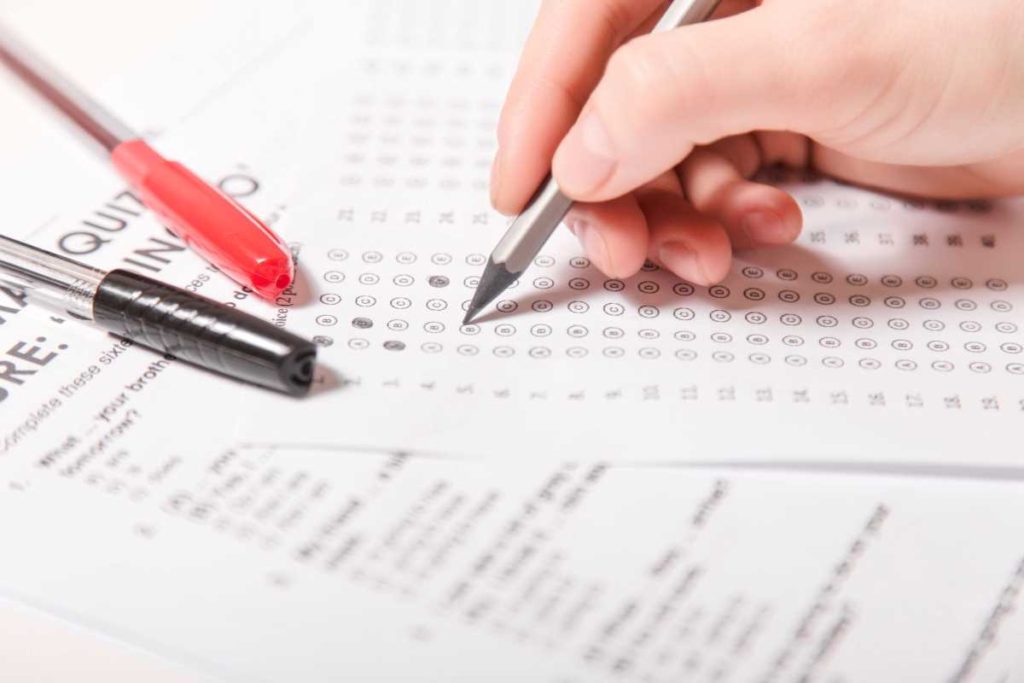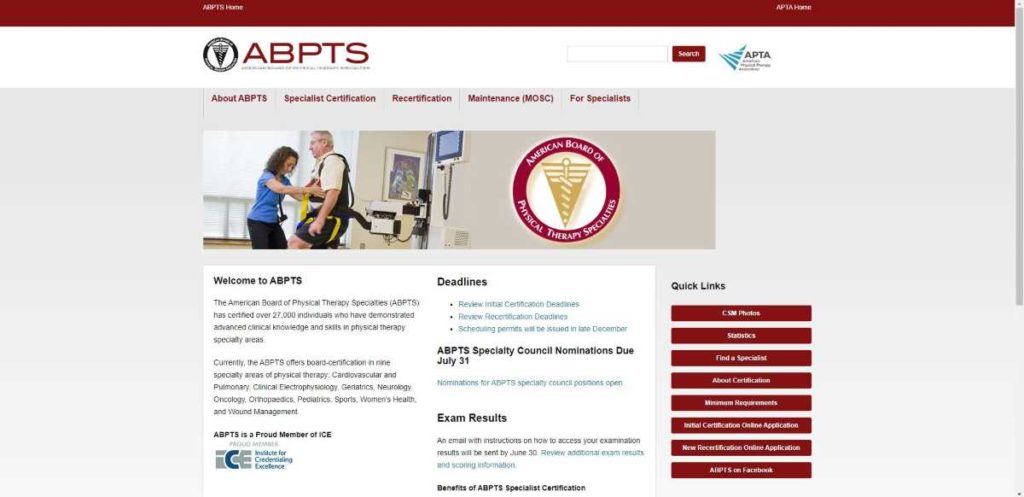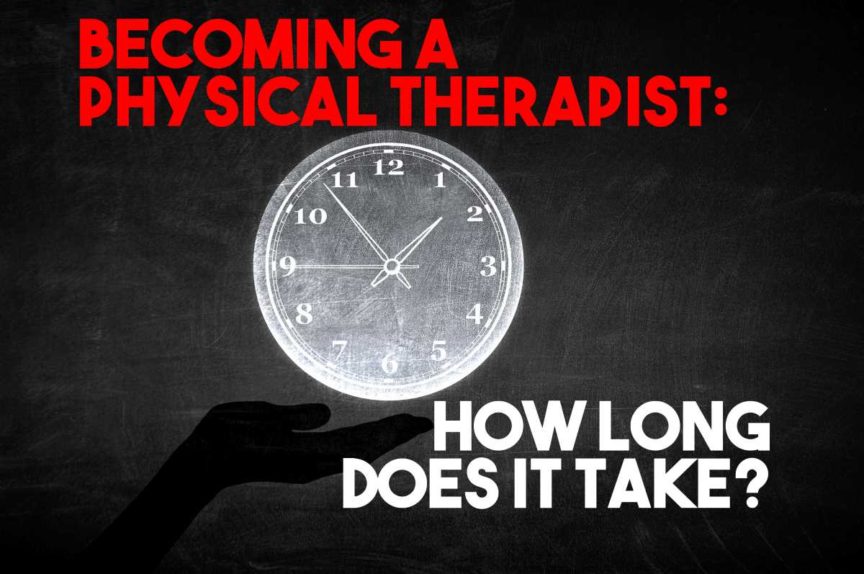Becoming a licensed physical therapist within the United States is an amazing achievement, and one that takes a lot of dedication and patience among other things. If you’re wondering how long it takes to become a licensed physical therapist and what one must go through, then this article has you covered!
The short answer is that it takes seven years of schooling (four years of undergraduate studies & three years of PT school) in order to become a physical therapist. After graduating from PT school, the individual must pass the National Physical Therapy Exam (NPTE) and hold a state license in order to begin practice.
There’s a lot that goes on throughout these seven years of schooling, and a number of certain steps that the individual must take along the way in order to become licensed. And of course, after graduating many physical therapists pursue specialized training in order to hold a specialty designation within the field of physical therapy.
A quick overview of this article
Step 1: Undergraduate studies, course prerequisites and GPA requirements
Step 2: Typical PT school application requirements
Step 3: PT school
Step 4: Specialty designations
Undergraduate studies, course prerequisites and GPA’s for aspiring physical therapists

Completing an undergraduate degree is one of the first major hurdles to clear in order to become a physical therapist. Ultimately, the specific undergraduate degree you receive doesn’t matter, provided that you graduate with the required course prerequisites that PT schools are looking for.
That being said, undergraduate degrees that center around the human body (kinesiology, exercise physiology, biology, etc.) can perhaps prepare you a bit more for PT school, but there’s a lot to unpack with that statement. For the sake of this article, just know that you have to graduate with the following prerequisites:
Anatomy – one course
Physiology – one course
Chemistry – two courses
Physics – two courses
Biology – one or two courses
Psychology – one or two courses
Statistics – one course
NOTE: All of these courses (with the exception of psychology and statistics) must also have laboratory components completed in addition to the lecture portions of the course.
As well, many schools will accept two semesters of combined anatomy & physiology (AP I and APII) in place of a dedicated course for anatomy and physiology.
If you want a much more extensive breakdown of required courses, complete with percentages of schools that require each of these prerequisite courses, be sure to check out my articles: What Prerequisite Coursework is Required for PT School in the US? and Is it Hard to Get Into PT School? Here Are the Facts!.
If you’d like a quick, visual reference PDF document to check out prerequisite requirement for each school, check out the PTCAS’s Comparison of Course Prerequisites By Program web page. You can also download a PDF version once you’re on the page.
GPA requirements for acceptance into PT school
You’ll need to carry a pretty solid GPA in all of these prerequisite courses. According to the CAPTE’s 2019-2020 Aggregate Data Report, the average GPA for PT applicants who are accepted across all schools within the US is around 3.5 on a 4.0 scale.
It’s also worth noting that PT schools can have two specific GPA requirements: The first requirement being a minimum GPA for all of the previously mentioned prerequisite coursework and the second GPA requirement being an overall minimum GPA score across ALL of your undergraduate courses.
Both of these GPA scores will likely need to be north of 3.5 in order to have a reasonable chance of entering the majority of PT schools, however this is largely dependent upon each individual school.
Typical physical therapy school application requirements
There can be a myriad of individual steps that you’ll need to check off your list when it comes to successfully completing the required criteria for applying to a PT school. While every school tends to have slightly different requirements, there are some largely universal things that you’ll have to do or at least know about. If you know the school(s) you’re interested in applying to, checking in with them for specific requirements is your best bet.
The following subsections below will help give you some more specific information you should be aware of if you’re considering applying to PT school:
Does the school use the PTCAS system?

PTCAS stands for Physical Therapy Centralized Academic Service (link takes you to their website) and is a centralized clearinghouse for the vast majority of PT schools within the US. Not every school uses PTCAS, but well over 75% of them do.
If the school does use PTCAS, everything pertaining to the school(s) you’re applying to will go through this system. You will create an account and then submit official transcripts, essays, reference letters and just about anything else you can think of to this body. From there, they will relay out your application documents to the school(s) you’re applying to.
If you need a quick resource to check out which schools use PTCAS and which ones don’t, head on over to this link on the PTCAS website: List of PTCAS Programs (you can choose to look through either a list of PTCAS-participating programs or non-PTCAS participating programs).
Clinical observational hour requirements for PT school
Most PT schools require their applicants to complete a specified number of volunteer hours observing in one or more clinical settings in which physical therapists work. This is done for a couple of different reasons, but primarily so that applicants know that PT is a career they can see themselves in as well as being a little bit better prepared for PT school itself.
Most schools require volunteer hours to be completed (but not all), and the hour requirements can vary drastically. The specific stats are beyond the scope of this article, but if you want to know the breakdown of these hours across schools, you can check out my blog post: PT School Observation Hours: How Many Are Needed for Applicants? in which I break down a lot of this information.
Start your observation hours well in advance of your application deadlines
If the school(s) you’d like to apply to in fact do require observation hours, it’s best to complete them (or at least start them) far in advance of your application and any deadlines that you may be up against. Some applicants have to complete well over one-hundred hours while other applicants can have a hard time finding clinics to observe in that meet the specific requirements of the school(s) they wish to apply to.
Does the school require you to write the GRE?

The GRE stands for the Graduate Records Examination and is a requirement for a high number of PT schools, though not all. It is a standardized exam that is a requirement for many graduate schools, not just specifically for PT school. This examination tests an individual on their abilities regarding verbal and quantitative reasoning, components of analytical writing as well as critical thinking ability. More specifically, the exam is broken into sections covering algebra, geometry and arithmetic along with vocabulary sections.
It’s important to know that this exam has no bearing on how well you’re likely to do in PT school, but is rather just an unfortunate hoop many PT applicants have to jump through. I took the GRE twice and walked away with largely mediocre scores, but I still crushed PT school.
You’ll likely want to find ways to study for the GRE and prepare for it as best as you can since PT schools requiring you to take this exam will have a minimal score that you’ll need to hit. Keep in mind that the minimum is simply that – the higher the applicant’s GRE score, the better off they’ll be in the application standings.
School-specific essays for PT applicants
Many schools will require an applicant to write a school-specific essay in addition to a standardized essay that they typically must write if applying through the PTCAS. These essays can vary based on the individual school, but typically ask the applicant to write an essay around the topic of physical therapy and/or why the individual believes they are worthy of a seat in the school’s PT program.
While these essays can take some time to write, you’ll want to ensure that you do the best job possible when constructing them, followed up thereafter with lots of proofreading. These essays are often as close to a personal introduction that you’ll get with these schools, so finding ways to professionally stand out within your writing can be rather crucial.
The formal interview for PT applicants

If the school you’ve applied to likes what they see on paper, they will likely request a formal, in-person interview on their campus. Not every school has a formal interview process, but many schools do. This interview often represents the final hoop to jump through in a seemingly long and arduous application process for those who want to become a physical therapist.
While not every applicant that gets called for an interview ultimately finds a spot at that particular school, preparing for the interview itself and taking it as seriously as possible can greatly help increase your chances of being offered a seat within the school’s program. If you think you could use some critical tips to help you crush your interview process, be sure to check out my blog post: Five Top Tips on How to Achieve a Successful Interview for PT School.
Physical therapy school: A quick overview

When it comes to PT school itself, you’ve essentially got three years of stuffing material into your head at what will often feel like an incredibly quick rate. While the perceived complexity of material can range drastically between one student to the next, most students will agree that PT school keeps you very busy. Even if the material isn’t challenging to the student, there’s still a ton to learn. Mix this in with assignments, clinical rotations and other demands of PT school and you’ll likely feel that time is moving rather quickly.
Students spend their didactic days covering a baseline of material that is required to have been learned in order to be able to successfully pass their National Physical Therapy Examination (NPTE). In that sense, nearly every course carries a specific purpose towards preparing the student to have the knowledge and insight for that respective section found on the NPTE.
If you’re wondering what these specific courses are, head on over to my blog post: What Courses do DPT Students Take in PT School?, where I give a detailed breakdown of each and every type of course that PT students take while in school.
The national board exam for PT licensure
The National Physical Therapy Examination (NPTE) is the final obstacle standing in the way between the PT student and the ability to add the letters “PT” as a designation after their name. The exam can only be written after the student has been cleared to do so by their institution.
The exam is administered by the Federation of State Boards of Physical Therapy (FSBPT) (link takes you to their website) and consists of 250 questions (50 of which are pilot questions for future examinations). It is a multiple-choice, computer-based exam.
While the scoring for passing or failing the exam is not based on a standard percentage, students hoping to pass the exam need to score above approximately low 70’s in terms of percentage in order to pass.
Specialty designations for physical therapists after graduation
While passing the NPTE allows an individual to receive their license to practice physical therapy, many individuals choose to earn specialty designations that allow for an expanded scope of practice within their chosen realm of physical therapy.

The American Board of Physical Therapy Specialties (ABPTS) (link takes you to their website) recognizes and offers ten specialty designations (i.e. specialty areas of clinical practice) for the profession of physical therapy:
- Cardiovascular & Pulmonary
- Clinical Electrophysiology
- Geriatrics
- Neurology
- Oncology
- Orthopaedics
- Paediatrics
- Sports
- Women’s health
- Wound management
According to the ABPTS website, their specialist certification program has been established as a means to provide recognition for physical therapists who have extended or advanced knowledge, skills and expertise for their specialty area of practice. It has also been established as a means to benefit consumers and the health care community.
Concluding remarks
It takes seven years of academic school work and passing the NPTE in order to become a licensed physical therapist within the US.
After four years of undergraduate studies successfully fulfilling the coursework prerequisites for PT school (in conjunction with a GPA north of 3.5), students should begin collecting volunteer hours in PT clinics, based on the requirements of the school(s) that they’re considering applying to.
Observation hour requirements can be unique for each school, so it’s always wise to begin this process well in advance of any application deadlines.
Additional steps might need to be taken in addition to observation hours, again based on individual school requirements. These additional steps include potentially writing the GRE, submitting letters of reference, writing essays and more.
If required, applicants may be requested by the school to attend a formal interview.
Once admitted into PT school, students have three years of didactic and clinical-environment rotations that they must complete before being eligible for writing the National Physical Therapy Examination (NPTE).
Once a licensed physical therapist, additional board specialties can be attained through continued training for those wishing to do so.

Hi! I’m Jim Wittstrom, PT, DPT, CSCS, Pn1.
I am a physical therapist who is passionate about all things pertaining to strength & conditioning, human movement, injury prevention and rehabilitation. I created StrengthResurgence.com in order to help others become stronger and healthier. I also love helping aspiring students and therapists fulfill their dreams of becoming successful in school and within their clinical PT practice. Thanks for checking out my site!

